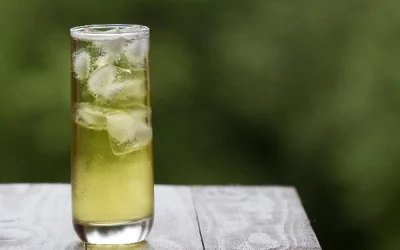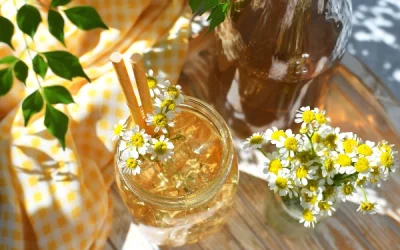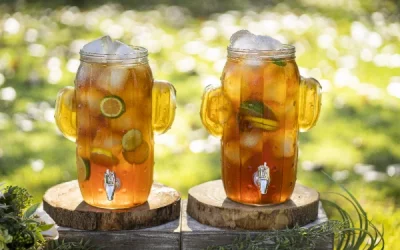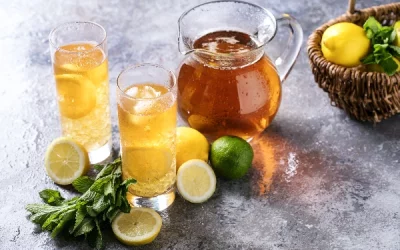Have you ever savoured the refreshing taste of sweet tea on a sultry summer day? This beloved beverage is more than just a drink; it’s a cultural icon of the Southern United States, steeped in history and hospitality. In this guide, we’ll explore the origins of sweet tea, how to brew the perfect cup, its health implications, variations, and food pairings that enhance its charm. Join me as we uncover the secrets to enjoying this sweet Southern tradition that has captivated taste buds across the globe.
Table of Content
- What is sweet tea and why is it popular?
- How do you make the perfect sweet tea?
- What are the health implications of drinking sweet tea?
- Can sweet tea be made without sugar?
- What are the best flavour variations of sweet tea?
- What are some traditional food pairings with sweet tea?
- How do you store and serve sweet tea?
- Is sweet tea popular outside the Southern United States?
- Conclusion
What is sweet tea and why is it popular?
Sweet tea is more than just a drink in the Southern United States; it’s a cultural staple that embodies hospitality and tradition. By definition, sweet tea is a form of iced tea where black tea is sweetened with sugar while still hot, then cooled and served over ice.
Its origins trace back to the early 19th century when tea was a luxury item, and sugar was plentiful in the South due to the sugarcane industry. This beverage has become a symbol of Southern identity, enjoyed at family gatherings, social events, and served to guests as a gesture of welcome.
The cultural significance of sweet tea is rooted in its association with Southern hospitality. Offering a glass of sweet tea is like offering a slice of the South itself—warm, welcoming, and comforting.
Preparation techniques vary, but the essence remains the same: strong brewed tea, generous amounts of sugar, and ice. Over the years, variations like adding lemon, mint, or even a splash of bourbon have emerged, but the traditional recipe remains a favourite.
What are the key ingredients in sweet tea?
Sweet tea’s simplicity is part of its charm. The primary ingredients are:
- Black tea leaves or tea bags
- Granulated sugar
- Water
- Ice
Some variations may include:
- Lemon slices for a citrusy twist
- Mint leaves for added freshness
- Baking soda to reduce bitterness
To make sweet tea, you need to brew the tea leaves in boiling water, dissolve the sugar in the hot tea, and then let it cool before serving it over ice. This method ensures the sugar fully integrates, making every sip consistently sweet.
How does sweet tea differ from regular iced tea?
While both sweet tea and regular iced tea are served cold, the key differences lie in their preparation and sweetness levels:
- Sweetening Process: Sweet tea is sweetened while the tea is still hot, allowing the sugar to dissolve completely. Regular iced tea is usually sweetened after it cools.
- Sugar Content: Sweet tea has a higher sugar content, giving it a distinctly sweet flavour. Iced tea can be unsweetened or have minimal sugar.
- Cultural Context: Sweet tea is deeply ingrained in Southern culture, often associated with hospitality and social gatherings. Regular iced tea is more universally consumed across the United States without specific cultural ties.
These differences make sweet tea a unique and cherished beverage, especially in the Southern United States.
Why is sweet tea considered a cultural symbol?
Sweet tea’s status as a cultural symbol in the South is due to several factors:
- Historical Roots: Its history dates back to the 19th century, intertwined with the region’s sugarcane industry.
- Social Rituals: Serving sweet tea is a traditional gesture of hospitality and friendliness.
- Regional Identity: It’s a beverage that captures the essence of the Southern way of life—relaxed, inviting, and community-oriented.
- Family Traditions: Many families have their own sweet tea recipes passed down through generations.
These elements collectively make sweet tea not just a drink but a representation of Southern culture and heritage.
In the 1830s, the first known sweet tea recipe appeared in the cookbook “The Kentucky Housewife” by Lettice Bryan. This early mention highlights how sweet tea has long been part of Southern culinary practices.
The drink’s journey from a luxury to an everyday staple reflects broader economic and social changes in the South, further cementing its cultural significance.
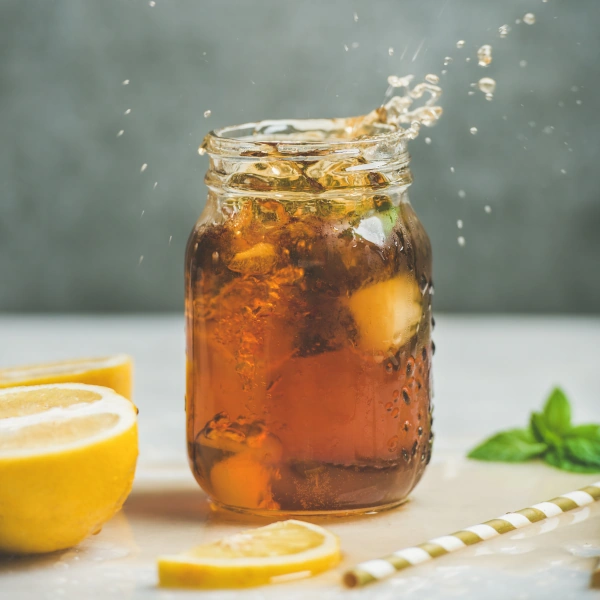
How do you make the perfect sweet tea?
Making the perfect sweet tea is all about balancing flavours while keeping it simple. You can follow a step-by-step process to ensure you get the best results. Sweet tea, especially in Southern cuisine, is more than just a drink – it’s a tradition. Here’s how you can make it at home.
Begin by brewing your tea. You’ll want to use black tea for the classic flavour, although you can also use green tea for a lighter taste. Boil water and steep the tea bags for about 5 minutes.
Remove the tea bags and add sugar while the tea is still hot, which helps the sugar dissolve completely. Once the sugar is dissolved, let the tea cool down before adding ice. For an extra touch, you can add a slice of lemon or a sprig of mint.
Step-by-step process
- Boil 4 cups of water.
- Add 5-6 tea bags and steep for 5 minutes.
- Remove tea bags and add 1 cup of sugar while the tea is hot.
- Stir until sugar dissolves.
- Let the tea cool to room temperature.
- Transfer to a pitcher and add 4 cups of cold water.
- Serve over ice with lemon or mint, if desired.
Here’s a comparison table of different sweet tea recipes that you can try. The table includes variations with fruit or herbs, preparation times, serving suggestions, and notes on sweetness levels. This will help you decide which version suits your taste best.
| Recipe Name | Ingredients | Preparation Time | Serving Suggestions | Notes on Sweetness Levels |
|---|---|---|---|---|
| Classic Southern Sweet Tea | Black tea, sugar, lemon | 15 minutes | Serve with lemon slices | Traditional, medium sweetness |
| Peach Sweet Tea | Black tea, sugar, peach slices | 30 minutes | Garnish with fresh peach slices | Sweet with a fruity touch |
| Mint Sweet Tea | Black tea, sugar, fresh mint | 20 minutes | Serve with mint leaves | Refreshing, moderate sweetness |
| Green Sweet Tea | Green tea, honey, lemon | 15 minutes | Add lemon slices | Light sweetness, healthier option |
| Berry Infused Sweet Tea | Black tea, sugar, mixed berries | 30 minutes | Include fresh berries in the glass | Berries add natural sweetness |
| Lemon Basil Sweet Tea | Black tea, sugar, lemon, fresh basil | 25 minutes | Top with basil and lemon slices | Herbaceous and slightly sweet |
| Orange Ginger Sweet Tea | Black tea, honey, orange slices, ginger | 30 minutes | Garnish with orange slices and ginger | Spicy sweetness |
Understanding this table can help you plan for the type of sweet tea you’d like to make. Each recipe has a unique twist, bringing different flavours and experiences to the table.
What are the benefits of drinking sweet tea?
Sweet tea is not just a refreshing drink; it also comes with several benefits. Drinking tea can be a delightful way to stay hydrated, and it offers a variety of flavours that can cater to different taste preferences. The moderate amount of caffeine can give you that needed energy boost, and if you use less sugar or natural sweeteners, you can enjoy it without the guilt.
- Hydration: Drinking tea helps you stay hydrated, especially during hot weather.
- Antioxidants: Tea is rich in antioxidants, which are good for your health.
- Energy Boost: The caffeine content can provide a mild energy lift.
- Customisable: You can adjust the sweetness and flavour to suit your taste.
- Digestive Aid: Tea can help with digestion and may soothe the stomach.
Sweet tea can be an enjoyable addition to your daily routine, providing a comforting and familiar taste. Drinking it in moderation ensures you reap the benefits without overloading on sugar.
How can you customise your sweet tea?
Customising your sweet tea allows you to experiment with flavours and find the perfect blend for your taste preferences. Adding fruits, herbs, or even spices can transform a simple sweet tea into an exciting new beverage.
- Fruits: Try adding slices of peach, berries, or citrus fruits for a fruity twist.
- Herbs: Mint, basil, or rosemary can provide a refreshing herbal note.
- Sweeteners: Use honey, agave, or stevia as alternatives to sugar.
- Spices: Ginger or cinnamon can add a warm and spicy flavour.
- Iced Variants: Freeze fruits or herbs in ice cubes to slowly infuse the tea as they melt.
Experimenting with these customisations can make your sweet tea unique and tailored to your liking. Whether you prefer it fruity, herbal, or spicy, there’s a combination out there for you.
The history of sweet tea dates back to the early 20th century in the Southern United States. One notable mention is the World’s Fair in St. Louis in 1904, where iced tea became widely popular.
Richard Blechynden, a tea merchant, decided to serve hot tea with ice due to the sweltering heat, which led to the creation of iced tea. This event played a significant role in spreading the popularity of sweet tea across the country.
What are the health implications of drinking sweet tea?
Sweet tea, the liquid gold of the South, is a staple in Southern cuisine. It’s like a refreshing hug on a hot day, but what’s the catch? While it’s undeniably tasty, not everything that’s sweet has a sweet impact on your health. Let’s dive into the nitty-gritty details.
Nutritional aspects of sweet tea
Sweet tea is essentially black tea loaded with sugar and, sometimes, a slice of lemon. While the tea itself isn’t the villain of the story, the sugar content is a bit of a drama queen. The calorie count can skyrocket while hydration might offer some benefits, the sugar crash that follows can bring you back down to earth, fast.
- Calorie Count: A typical glass can range from 100 to 150 calories, thanks to the hefty sugar content.
- Sugar Alternatives: Think stevia, honey, or even agave syrup. They can give you that sweet kick without the sugar overload.
- Hydration Benefits: Sweet tea still counts as a liquid intake, so you’re hydrating. Yay for that!
- Health Risks: High sugar levels can lead to weight gain, diabetes, and other health issues. Keep an eye on that waistline!
So, while sweet tea can hydrate and delight your taste buds, it’s a sugar bomb waiting to explode. Moderation is your best friend here.
How much sugar is typically found in a glass of sweet tea?
Let’s not beat around the bush – sweet tea loves sugar. We’re not talking about a sprinkle but more like a waterfall of the stuff. Typically, a glass of sweet tea can contain around 22 to 34 grams of sugar. To put it into perspective, that’s roughly 5 to 8 teaspoons. Making it a sugar paradise for your taste buds but a calorie nightmare for your diet.
- Commercially Available: Pre-made versions often have between 22 to 34 grams per serving.
- Homemade Varieties: You control the sugar, less or more is at your whim.
- Comparison: A can of soda has around 39 grams, sweet tea’s sugar affair is similar.
- Impact: Consuming this daily? Expect a few extra notches needed on the belt.
Sugar in sweet tea is a double-edged sword; it makes it delicious but also ventures into risky territory for your health.
What are some healthier alternatives to sugar in sweet tea?
Alright, so you love your sweet tea, but you’re not too keen on inviting sugar-related health issues to the party. Don’t sweat it – there are plenty of sugar substitutes out there that won’t turn your tea into a diabetic’s nightmare.
- Stevia: This plant-derived sweetener is a popular zero-calorie alternative.
- Honey: A natural sweetener that adds a unique flavour but does carry calories, so use sparingly.
- Agave Syrup: Lower on the glycemic index but still sweet enough for your tea.
- Maple Syrup: Offers a rich, unique taste, but again, use in moderation.
- Erythritol: Low-calorie and doesn’t spike blood sugar levels.
Switching out sugar for any of these options can make your tea a guilt-free indulgence. You still get the sweet but without the sour health implications.
Are there any health benefits to drinking sweet tea?
You might think sweet tea and health are like oil and water—they just don’t mix. But let’s not throw the baby out with the bathwater. While excessive sugar is a no-go, the tea itself can actually do some good.
- Antioxidants: Black tea is loaded with them, helping fight free radicals.
- Hydration: It keeps you hydrated, crucial for overall bodily functions.
- Caffeine Boost: A natural pick-me-up without as much crash as coffee.
- Possible Lowering of “Bad” Cholesterol: Some studies suggest black tea may reduce LDL cholesterol levels.
- Sociability: Sharing a pitcher with friends over a chat can reduce stress – social benefits count too!
There are indeed upsides to drinking sweet tea, provided you manage the sugar intake wisely. Think of it as the occasional treat rather than an everyday beverage.
Speaking of treats, let’s take a trip down history lane to the American Civil War. Soldiers often lacked fresh water and turned to tea for hydration. Sweetening tea became a way to make water palatable during those times of scarcity.
It evolved into a staple drink that even today conjures up images of Southern hospitality and genial conversation. It’s a legacy drink but with a modern twist – moderation and healthier alternatives can help you enjoy it without the downsides.
Can sweet tea be made without sugar?
Oh, look at you being all health-conscious! You growing plants in the backyard too? Anyway, you’re in luck because making sweet tea without sugar is totally doable. Bear with me and I’ll walk you through some clever ways to make your sweet tea minus the guilt trip from sugar.
We’ll talk sugar substitutes, natural sweeteners, and even how you can still savour tea without any sweeteners. Excited? You should be.
Switching out sugar can be a game-changer. There’s something uniquely delightful about sipping a chilled glass of sweet tea on a hot day. But if you’re worried about that waistline or wanting to keep things a little “sans sugar”, fear not, mate, we’ve got options that won’t make you miss the sweetness one bit.
What are some popular sugar substitutes for sweet tea?
Alright, let’s get straight to it. You can use:
- Stevia – This plant-based sweetener is super sweet (like, 200 times sweeter than sugar). A little goes a long way.
- Splenda – For those who don’t mind artificial sweeteners, Splenda is a popular choice. It dissolves well and provides that sweet kick.
- Monk Fruit – From the exotic lands of Southeast Asia, this sweetener is natural and has zero calories.
- Xylitol or Erythritol – These sugar alcohols add sweetness without spiking your blood sugar. They also have a cooling effect.
- Honey Granules – Feeling a bit fancy? Sprinkle some honey granules in your brew for a more natural touch.
Switching your sweetener might alter the flavour slightly, but these substitutes ensure you still get that sweet rush without traditional sugar.
How do natural sweeteners affect the taste of sweet tea?
Natural sweeteners bring their own kind of magic to the table. They not only sweeten but also add depth and character to your tea. Here’s how:
- Honey – A dollop gives a rich, floral sweetness. It’s like sunshine in liquid form.
- Maple Syrup – Think of it as giving your tea a charismatic woody hint, all while keeping it sweet.
- Agave Nectar – This one’s a bit like honey but milder. Great if you want a subtle, neutral taste.
- Coconut Sugar – Adds a slight caramel undertone to your tea. A hint of tropical vibes.
- Fruit Juices – Just a splash of apple juice or peach nectar and you’ve got a fruity twist.
Natural sweeteners not only change the sweetness level but also add their own unique profiles, making your tea not just sweet but furiously flavourful.
Can sweet tea be enjoyed without any sweeteners?
Can you believe it? You can actually sip on tea without anything sweet at all. There are several tricks to make unsweetened tea enjoyable:
- Fruit Infusions – Toss in slices of orange, lemon, or berries for natural fruity notes.
- Herbs and Spices – Mint leaves, basil, or even a cinnamon stick can add aromatic flavours.
- Strong Brew – Use more tea bags or let it steep longer to get a richer tea flavour.
- Chilled Nature – Ice-cold tea sometimes has an inherently refreshing taste that sugar-free folks love.
- Vanilla or Almond Extract – A drop or two can make your tea blend subtly sweet and fragrant.
Enjoying tea without sweeteners can bring out the authentic tea flavour and the little nuances you might miss with a sugary overload.
Once upon a time during the Civil War, when sugar was a precious commodity, Southerners needed to get resourceful. Sweet tea as we know it wasn’t possible, so they used whatever they could find to make their tea pleasant.
People infused their teas with mint, lemon, and even brandy (for an extra kick), proving that even in tough times, the quest for a delicious, refreshing drink continues. So, look at you, in the modern age, turning to zero-sugar-sweetened tea – you’re just carrying on a time-honoured tradition of making do with what you have, and making it fabulous.
What are the best flavour variations of sweet tea?
You know how sweet tea is already the drink of the gods? Imagine taking that divine elixir and adding a twist that makes it even more heavenly. Let’s dive into those flavour variations that can turn your sweet tea from “Oh, that’s nice” to “Holy moly, this is fantastic!”
Lemon, peach, mint, and even some unexpected additions can transform your sweet tea experience. Lemon is a classic—zesty and refreshing. Peach brings a subtle sweetness that screams summer.
Mint is downright cooling and invigorating. And then there are the wildcards like berry and basil. Let’s break these down and see how to jazz up your sweet tea concoctions.
How can you incorporate fruit flavours into sweet tea?
Fruit flavours are like the glitter of the culinary world—sparkly and irresistible. Here’s the lowdown on making your sweet tea fruity and fabulous:
- Fresh Fruit: Slice it up and dunk it straight into the pitcher. Lemons, peaches, berries; go nuts.
- Fruit Purees: Blend fruits like mango or strawberries into a smooth puree and mix it in.
- Fruit Juices: Grab some high-quality, 100% fruit juice and incorporate it right into the tea for a burst of freshness.
- Infused Syrups: Make a simple syrup but add fruits while boiling. Let it cool, strain, and voilà!
- Dehydrated Fruits: Toss in slices of dried fruits for a slow release of flavours, perfect for a more subtle infusion.
Give these a go and you’ll wonder how you ever drank plain sweet tea.
What herbs pair well with sweet tea?
Sweet tea and herbs—sounds fancy, right? But it’s so easy to do. Check out these pairings:
- Mint: The classic choice. It’s cool, refreshing, and pairs well with lemon.
- Basil: Sweet and slightly peppery, it goes surprisingly well with berry flavours.
- Rosemary: Earthy and aromatic, ideal with citrus.
- Lavender: Floral and calming, great with peach.
- Thyme: Lemon thyme can add a nice zing when paired with plain sweet tea.
Herbs can add complexity to your sweet tea, making you look like a beverage genius.
How do flavour variations change the traditional sweet tea experience?
Ah, the mighty traditional sweet tea. While perfection already, jazzing it up can make it feel like a whole new drink. Here’s how flavour variations shake things up:
- Enhanced Aroma: Adding fruits or herbs gives the tea a wonderful scent that enhances the drinking experience.
- Depth of Flavour: Each additional ingredient can bring out the richness and subtleties of the tea itself, creating more layers of taste.
- Seasonal Adaptability: Different flavours can match the seasons, like peach for summer or cranberry for winter holidays.
- Visual Appeal: Let’s be honest, a sweet tea with floating lemon slices and mint sprigs looks stunning. Instagram-worthy, even.
- Personal Touch: Customising your tea makes it your own. It’s not just sweet tea; it’s your sweet tea.
These variations don’t just add flavours but elevate the humble sweet tea into an experience that can be both comforting and exhilarating.
During World War II, American GI’s stationed in the Southern United States were often introduced to sweet tea for the first time. They fell in love with its refreshing taste. Post-war, they missed the sweet tea and began recreating it back home, and some even added fruits and herbs reminiscent of their European travels.
The fascination with adding a twist to the traditional sweet tea might have stemmed from them trying to capture a bit of the South along with new worldly experiences. Fancy that—the contributions of war making our sweet tea even sweeter!
What are some traditional food pairings with sweet tea?
Alright, let’s talk about the magic duo that is sweet tea and Southern cuisine. If you’re looking to play the home chef and dazzle your guests, you’ve stumbled upon some gold. Sweet tea partners up flawlessly with a slew of traditional Southern dishes, creating a culinary symphony that’s both comforting and nostalgic.
Picture this: you’re biting into a crispy piece of fried chicken, and you take a swig of sweet, chilled tea. Absolute bliss, right? Let’s dive deeper.
What types of food are commonly served with sweet tea?
Down in the South, sweet tea isn’t just a drink; it’s practically an extension of life itself. This delightful beverage aligns perfectly with various Southern staples. Here’s a cheat sheet of foods that play well with sweet tea:
- Fried chicken: Extra crispy and juicy; wash it down with some sweet tea to balance the richness.
- Biscuits: Fluffy and warm from the oven. Slather on some butter, and let the sweet tea cleanse your palate.
- Barbecued meats: Ribs, brisket, and pulled pork slathered in BBQ sauce are offset nicely by the cool, sweet contrast of sweet tea.
- Desserts: Pies like pecan or peach, and cakes like red velvet or coconut; the sweetness of the tea complements the creamy textures.
With these pairings, you’re not just enjoying a meal; you’re having a bona fide Southern experience. Sweet tea adds a gentle nudge to the flavours, making each bite more satisfying.
How does sweet tea enhance the dining experience?
Sweet tea isn’t just another drink on the table; it’s the unsung hero of a Southern feast. Here’s how it makes your dining experience better:
- Balances flavours: Southern foods can be rich and heavy. Sweet tea offers a light, sweet diversion.
- Cool and refreshing: Amidst hot, spicy dishes, a cold glass of sweet tea is a cooling lifesaver.
- Versatility: It pairs well with almost everything, making it the Swiss army knife of beverages.
- Cultural touchstone: Pouring sweet tea for your guests immediately sets a relaxed, welcoming tone.
These points underscore why sweet tea is an iconic Southern staple. Imagine your taste buds doing the cha-cha; one sip and one bite complementing each other in perfect harmony.
Are there any regional variations in food pairings?
Even within the vast realm of Southern cuisine, sweet tea finds unique companions depending on where you are.
- Lowcountry: Think shrimp and grits paired with a glass of sweet tea.
- Appalachian: Pair it with cornbread and collard greens for an authentic taste.
- Texan: Enjoy it with a spicy bowl of chilli or smoky brisket.
- Creole/Cajun: Sweet tea cuts through the heat of jambalaya or gumbo like a hero.
Every nook and cranny of the South offers a twist on sweet tea pairings. These regional specialties add depth to your culinary adventure, making every sip and bite feel like a different chapter in a delicious novel.
Let’s rewind to the American Civil War era, when sweet tea began solidifying its place in Southern hearts. During that tumultuous time, iced teas were initially just served unsweetened. It wasn’t until sugar became more affordable post-war that sweet tea as we know it gained popularity.
John Palmer, a savvy English immigrant, capitalized on this by serving sweet tea at his upscale Charleston hotel. Word spread, and sweet tea became an integral part of the Southern identity, forever altering the landscape of beverages in America.
Let’s just say, without good ol’ John mixing up his tea, our summer picnics would be far less sweet and far less Southern.
How do you store and serve sweet tea?
Storing and serving sweet tea isn’t exactly rocket science, but hey, even the simplest things deserve a bit of attention. Sweet tea, that nectar of the South, needs proper care to be at its best.
First up, let’s talk refrigeration. Never, ever think about leaving this sweet liquid gold out on the counter. You’ll want to keep it chilled in the fridge at all times. And for Pete’s sake, put it in an airtight container; you don’t want your tea smelling like last week’s lasagne.
Serving temperature is another thing. Let’s be honest, no one wants lukewarm sweet tea. Cold is the name of the game. Serving it over a mound of ice is standard practice, ensuring it’s as refreshing as possible.
Longevity is where things get interesting. Sweet tea can last a few days in the fridge but don’t push it too far unless you like the idea of bland, stale tea.
How long can sweet tea be stored in the fridge?
Sweet tea can typically be stored in the fridge for up to five days. Beyond that, the flavour starts going downhill faster than a souped-up go-kart.
- Store in an airtight container to maintain freshness.
- Keep it in the back of the fridge where it’s coldest.
- Add a bit of lemon to prolong its life by a day or so (and add some zing).
- Avoid storing it in plastic containers if possible; glass jars are the way to go.
- Check for any weird smells or changes in flavour before drinking.
This brew is a bit of a diva—handle it right, and it’ll reward you with those sweet, sweet sips.
What is the best way to serve sweet tea?
Serving sweet tea the right way is an art form. You don’t just dump it in a cup and call it a day. Here’s how to roll out the red carpet for this Southern classic.
- Use clear, tall glasses, because presentation matters.
- Fill the glass almost to the top with ice. Crushed ice is a top choice if you can manage it.
- Add lemon wedges or mint for some flair and extra flavour.
- Offer sugar on the side for those who crave a sweeter punch.
- Use a fun, colourful straw because why not?
Serving it with style makes the experience more enjoyable and truly refreshing.
Can sweet tea be reheated?
Reheating sweet tea is where things get a bit controversial. While it can technically be done, it’s generally a terrible idea. Cold sweet tea is what dreams are made of; warm sweet tea is more like a nightmare.
- If you must reheat, use a microwave-safe container.
- Heat for short bursts of 10-15 seconds; you don’t want to end up with boiling tea.
- Stir well to mix the sugar evenly.
- Reheat only a single serving; don’t try warming up the whole batch.
- Consider adding a fresh slice of lemon or some fresh mint to revitalise the flavour.
Remember, reheated sweet tea will never be as good as the original cold version, so it’s best as a last resort.
Speaking of Southern traditions and quirks, did you know General Robert E. Lee had quite the affection for sweet tea? During the Civil War, Southern soldiers often brewed tea on the battlefield to keep morale up.
Lee himself was a fan, quipping that a glass of sweet tea could momentarily make soldiers forget the harsh realities of war. So, next time you sip on a cold glass of sweet tea, remember you’re indulging in a time-honoured comfort.
Is sweet tea popular outside the Southern United States?
Despite being a Southern staple, sweet tea has indeed spread its refreshing charm beyond the Mason-Dixon line and even popped up in some far-flung corners of the globe. So yes, sweet tea is having a global moment, albeit with some interesting tweaks, twists, and turns.
Walking you through this journey, let’s look at how sweet tea waltzed its way out of the Southern United States and settled into new homes across the world. We’ll explore how different cultures have embraced this beverage, what changes they made, and whether any notable brands have sweetened the pot outside the South.
How is sweet tea perceived in other cultures?
Sweet tea, with its sugary punch and icy chill, gets a mixed reception as it ventures into different cultures. For some reason, not everyone worships at the altar of sugar like we do in the South.
- Europe: There’s scepticism in some parts, particularly where tea is traditionally consumed hot and without heaps of sugar. While the British might wrinkle their noses at the sugar content, they’re still intrigued.
- Asia: In places like Japan and Thailand, variations are welcomed. Sweet tea is seen as a cousin to local favourites like milk tea or iced green tea.
- Australia: Down Under, cold teas are popular, especially given the similarity to their existing iced tea culture.
- Latin America: Enthusiasts here love sweet and refreshing drinks, so sweet tea isn’t much of a stretch for palates accustomed to horchata and agua fresca.
So, while sweet tea might raise some eyebrows, it’s generally considered a delightful, albeit eccentric, beverage addition.
What adaptations of sweet tea exist in other regions?
When sweet tea crosses borders, it undergoes transformations to better align with local flavours and ingredient availability. Different strokes, different folks, right?
- Japan: Infused with matcha or jasmine to suit local tastes and add an exotic twist.
- Thailand: Blends with condensed milk and spices, creating a rich, Thai iced tea-inspired version.
- Middle East: Sometimes combined with mint and lemon, aligning more closely to traditional herb-infused beverages.
- Australia: Black tea served ice-cold, heavy on the lemon, and sometimes, a touch of honey.
Adapting sweet tea allows it to fit into local palates and traditions, making it a versatile and beloved thirst quencher.
Are there any notable sweet tea brands outside the South?
Sure, some brands have successfully capitalised on sweet tea’s appeal and expanded beyond the traditional Southern market.
- Lipton: Globally present, offers sweet tea variants in various regions.
- Pure Leaf: Known for its quality, it’s found a home in many international supermarkets.
- Arizona Iced Tea: Always adventurous, they’ve launched sweet tea flavours worldwide.
- Nestea: A fixture in Europe and Asia, offering sweet tea as part of their refreshing lineup.
These brands managed to bottle a bit of Southern sunshine and send it all around the world, spreading the sweet gospel far and wide.
In the late 1800s, a savvy young man named Richard Blechynden decided to make his tea icy cold at the World’s Fair in St. Louis after realising no one wanted hot tea on a scorching summer day.
It was a hit and is often credited with giving birth to the iced tea phenomenon in the United States. This daring move is a testament to how a slight adaptation can turn a good idea into a global sensation.
Much like how sweet tea has found appreciation beyond its Southern origins!
Conclusion
As I reflect on the journey through the world of sweet tea, it becomes clear that this beloved beverage is more than just a refreshing drink; it is a symbol of Southern culture, hospitality, and community.
We explored the rich tapestry woven by its origins, unique preparation techniques, and regional variations, all contributing to the warm embrace that sweet tea extends to anyone fortunate enough to indulge.
The essential ingredients, alongside the contrast between sweet tea and regular iced tea, underline its distinctive role in our lives, garnering respect not only as a drink but as a tradition.
Understanding the nutritional implications of sweet tea prompts deeper conversations about our health choices. While we acknowledged the sugar content and potential health benefits, it was equally important to consider alternatives and the possibility of enjoying sweet tea without sugar.
This does not just pivot us towards a healthier lifestyle but also showcases the adaptability of this classic recipe.
Furthermore, the exploration of flavour variations and traditional food pairings highlights how sweet tea complements culinary experiences, enhancing gatherings around the dinner table. Whether it’s a slice of lemon or fresh mint, sweet tea invites creativity while still honouring its traditional roots.
As we close this guide, I encourage you to embrace the art of making sweet tea tailored to your tastes. Experiment with different flavours, share it with loved ones, and invite conversations that reveal the cultural significance behind every sip.
Just as sweet tea can soothe the soul in sweltering heat, it can also spur connections and memories. So, I leave you with this thought: in every glass of sweet tea lies a story – what will yours be?
Resources
- Health Benefits of Tea
- Tea and Health: Studies in Humans
- The Role of Tea in Human Health: An Update
- Does adding sugar to coffee and tea impact your lifespan? 32-year study reveals surprising results
- Stevia: What Is It and Is It Healthy?
- Are Artificial Sweeteners Bad for You?
- Calories in Sweet Tea – Nutritionix
- 10 Sweet Tea Nutrition Facts You Need To Know



